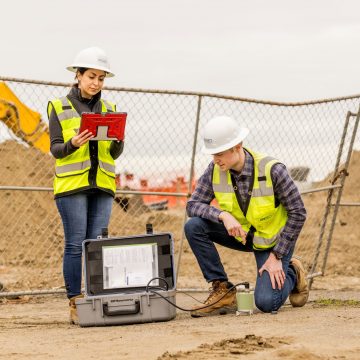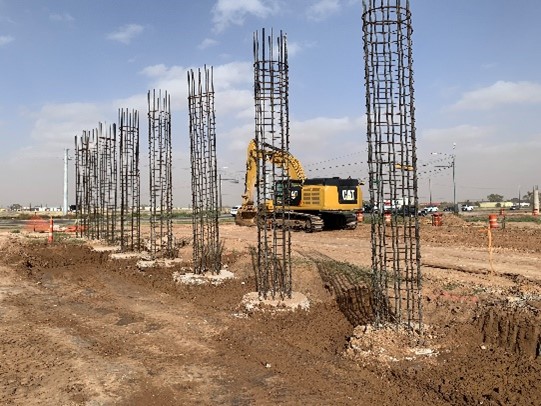Comprehending the Comprehensive Duty of Geotechnical Designers in Ground Examination and Dirt Evaluation for Building Tasks
Geotechnical designers are indispensable to the success of construction tasks, giving important insights through extensive ground examinations and soil analysis. Their expertise in analyzing dirt actions and using innovative screening strategies notifies vital decisions that support structural integrity and safety. By working together and identifying potential risks with multidisciplinary teams, these professionals considerably influence task results, including efficiency and cost-effectiveness. The ins and outs of their duty frequently expand beyond these features, motivating a deeper expedition right into the methods they use and the ramifications of their searchings for on overall job viability.
Role of Geotechnical Engineers
The critical function of geotechnical engineers in building projects can not be overstated, as they give important insights into soil habits and site conditions. These specialists are charged with evaluating the viability of the ground for numerous kinds of frameworks, making certain safety and security and stability throughout the building and construction procedure. Their expertise encompasses a large range of activities, including site characterization, dirt tasting, and research laboratory screening, which are crucial for determining the physical and mechanical properties of the dirt.
Geotechnical designers use their findings to create foundational styles that fit load-bearing demands and mitigate threats associated with soil liquefaction, slope, and negotiation security. They play an essential duty in determining potential threats, such as groundwater variations and contamination, which can substantially affect project feasibility. In addition, they work together with architects, civil designers, and service providers to make certain that geotechnical considerations are incorporated into the general design and construction stages.
Ground Investigation Methods
Ground examination strategies develop the foundation of geotechnical engineering, allowing designers to get a detailed understanding of subsurface conditions. These techniques are necessary for evaluating soil residential properties, establishing groundwater levels, and recognizing potential geological hazards.
Usual methods include borehole drilling, which enables the extraction of soil samples at numerous midsts, providing critical data for analysis. Additionally, sitting testing strategies, such as Basic Penetration Examinations (SPT) and Cone Infiltration Examinations (CPT), are used to review dirt stamina and thickness straight in the ground.
Geophysical methods also play a substantial function in ground examinations. Methods such as seismic surveys and electric resistivity tomography help examine subsurface characteristics without extensive excavation. geotech engineer. These non-invasive approaches are especially beneficial in big or sensitive areas where disturbance have to be decreased
Furthermore, exploratory trenches can be dug deep into to aesthetically examine dirt layers and identify any type of abnormalities. Each of these techniques adds unique understandings, allowing geotechnical designers to create precise website assessments and educate design decisions. In recap, a mix of these ground investigation techniques is crucial for effective building tasks, ensuring security and architectural honesty.
Dirt Analysis Methods
Soil evaluation approaches are essential for comprehending the chemical and physical properties of soil, which directly influence the style and building and construction of structures and other structures. Different methods are utilized to analyze soil characteristics, guaranteeing that geotechnical engineers obtain precise data for notified decision-making.
One frequently made use of approach is grain dimension analysis, which figures out the circulation of bit dimensions within a dirt sample. This is crucial for click here for more identifying dirt types and forecasting their actions under load. An additional important technique is Atterberg limitations screening, which assesses the plasticity and wetness web content of fine-grained dirts, offering understandings into their design residential or commercial properties.

Area tests, such as Conventional Penetration Tests (SPT) and Cone Infiltration Tests (CPT), offer important in-situ data regarding dirt stamina and stratification. Collectively, these dirt evaluation techniques form the foundation of geotechnical investigation, permitting designers to develop safe and reliable structures customized to the certain conditions of the website.
Danger Mitigation Techniques
Executing effective risk reduction techniques is vital for Learn More geotechnical engineers to resolve prospective difficulties in building projects. These approaches are important in determining, assessing, and taking care of dangers related to dirt problems, website stability, and groundwater fluctuations, which can negatively affect job results.
One primary approach includes conducting extensive site examinations that utilize innovative geophysical techniques and thorough soil tasting. By acquiring exact data on subsurface problems, designers can make informed choices on design and building and construction methods. Furthermore, using predictive modeling tools permits for the simulation of various situations, allowing engineers to predict potential problems and carry out safety nets.
Furthermore, establishing clear communication networks amongst project stakeholders promotes a collective strategy to risk administration. Normal updates and examinations make sure that all events recognize the developing website problems and can adapt their techniques appropriately.

Effect On Construction Tasks
The Visit Website effectiveness of risk reduction approaches straight affects the general success of building projects. Geotechnical engineers play an essential function in this domain name, as their proficiency in ground examination and soil analysis educates important choices throughout the building process. By accurately examining soil problems and recognizing possible hazards, these professionals make it possible for project groups to devise effective solutions that decrease risks related to ground instability, water infiltration, and other geotechnical difficulties.
The impact of comprehensive geotechnical analysis appears in different aspects of building and construction jobs, consisting of cost monitoring, job timelines, and structural stability. Early identification of concerns enables for prompt interventions, decreasing costly hold-ups and budget overruns. A comprehensive understanding of website problems improves the style and design process, making certain that structures are constructed to endure ecological stress and potential natural catastrophes.
Inevitably, the contributions of geotechnical engineers are indispensable to the successful execution of building tasks. Their work not just cultivates safety and compliance with guidelines yet also enhances the long-term sustainability of structures, making certain that they carry out successfully throughout their intended life-span. The partnership in between geotechnical groups and other stakeholders is crucial for achieving optimal outcomes in construction endeavors.
Conclusion
To conclude, geotechnical designers execute an essential function in construction tasks via comprehensive ground examinations and dirt evaluations. Their proficiency in assessing dirt actions, utilizing different investigation techniques, and implementing threat reduction techniques considerably adds to the structural honesty and security of built settings. By teaming up with multidisciplinary groups, these experts improve task efficiency and guarantee conformity with safety and security standards, inevitably leading to effective building and construction end results and lowered potential dangers.
Geotechnical engineers are indispensable to the success of building and construction jobs, supplying essential understandings through thorough ground examinations and dirt analysis.The crucial function of geotechnical designers in construction jobs can not be overemphasized, as they offer crucial insights right into soil actions and site problems. Their competence encompasses a large array of activities, consisting of website characterization, soil sampling, and research laboratory testing, which are critical for determining the mechanical and physical buildings of the soil.
By precisely analyzing soil conditions and determining possible hazards, these professionals allow task groups to devise efficient options that lower risks associated with ground instability, water infiltration, and other geotechnical challenges.
In final thought, geotechnical engineers carry out a critical feature in construction projects via extensive ground investigations and soil analyses.
Comments on “Fads Influencing the Future of Geotechnical Eng Practices”